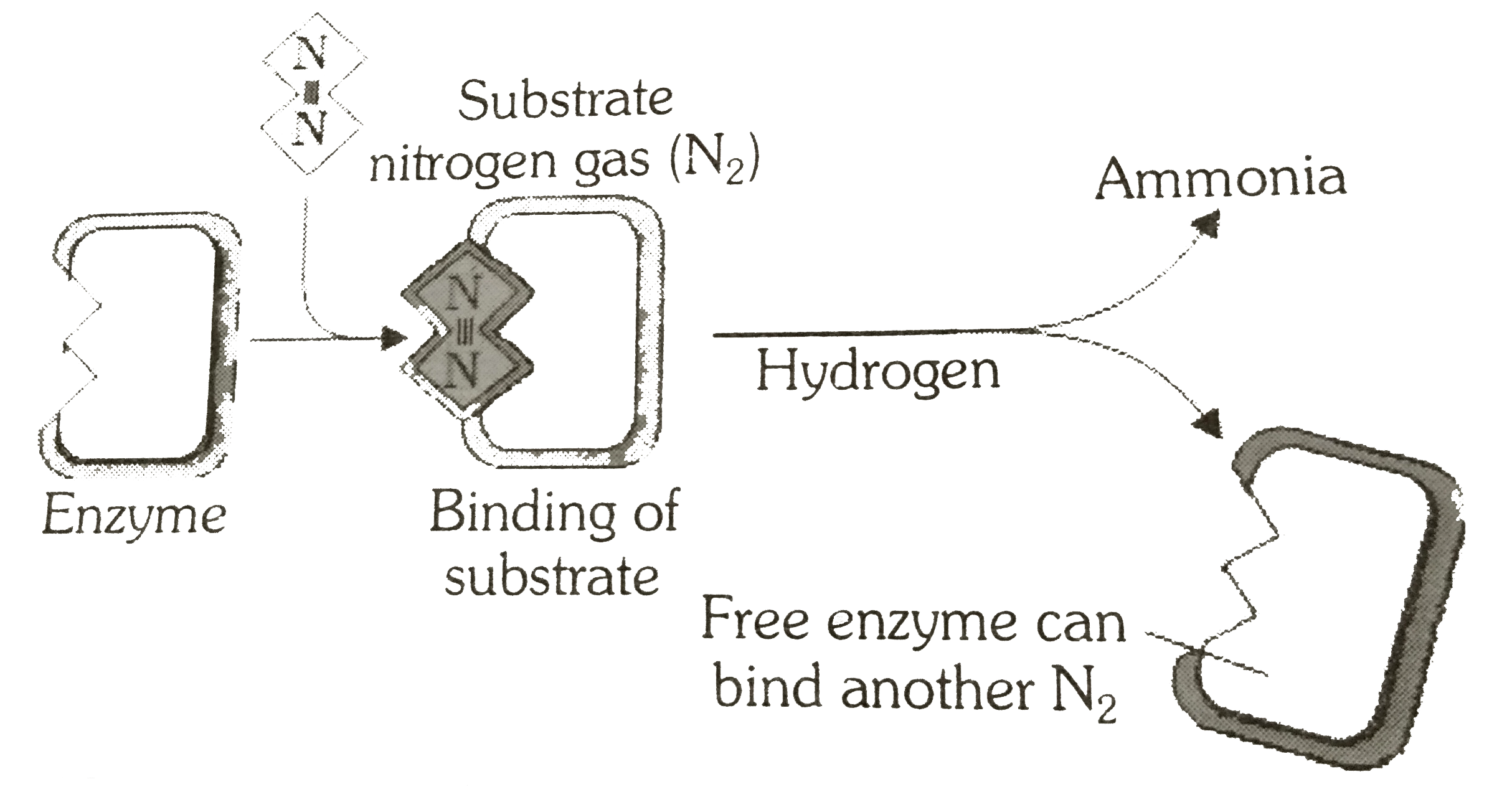Nitrogenase:
Is a Cu - Fe protein
Is present in all Prokaryotes
Can convert NH3 into N2
Is very sensitive to O2
The correct Answer is:D
Step-by-Step Solution:
1. Understanding Nitrogenase: Nitrogenase is an enzyme that plays a crucial role in nitrogen fixation, which is the process of converting atmospheric nitrogen (N₂) into ammonia (NH₃). This process is essential for making nitrogen available to living organisms.
Hint: Remember that nitrogen fixation is the conversion of atmospheric nitrogen into a usable form for plants.
2. Composition of Nitrogenase: The enzyme nitrogenase is composed of iron and molybdenum, not copper. It is found in certain prokaryotes, particularly in nitrogen-fixing bacteria.
Hint: Focus on the correct metal components of nitrogenase; it is important to differentiate between molybdenum and copper.
3. Function of Nitrogenase: The primary function of nitrogenase is to catalyze the conversion of atmospheric nitrogen (N₂) into ammonia (NH₃). This ammonia can then be utilized by plants for growth.
Hint: Keep in mind that nitrogenase facilitates the transformation of nitrogen gas into ammonia, which is a key nutrient for plants.
4. Sensitivity to Oxygen: Nitrogenase is highly sensitive to molecular oxygen (O₂). Exposure to oxygen can inhibit its function, which is why nitrogen-fixing bacteria often have mechanisms to protect the enzyme from oxygen.
Hint: Remember that nitrogenase cannot function properly in the presence of oxygen; this is a critical characteristic of the enzyme.
5. Role of L-hemooglobin: To protect nitrogenase from oxygen, some nitrogen-fixing bacteria produce a protein called L-hemooglobin. This protein acts as an oxygen scavenger, helping to create a low-oxygen environment for nitrogenase to function.
Hint: Consider the protective mechanisms that bacteria have developed to ensure nitrogenase can work effectively in aerobic conditions.
6. Types of Nitrogen-Fixing Bacteria: There are two main types of nitrogen-fixing bacteria: symbiotic (those that form relationships with plants, like legumes) and free-living (those that do not require a host plant).
Hint: Differentiate between symbiotic and free-living nitrogen-fixing bacteria and their ecological roles.
Summary:
Nitrogenase is an enzyme that converts atmospheric nitrogen into ammonia, is composed of iron and molybdenum, and is highly sensitive to oxygen. L-hemooglobin helps protect nitrogenase from oxygen, and there are both symbiotic and free-living nitrogen-fixing bacteria.
Nitrogenase is an enzyme that converts atmospheric nitrogen into ammonia, is composed of iron and molybdenum, and is highly sensitive to oxygen. L-hemooglobin helps protect nitrogenase from oxygen, and there are both symbiotic and free-living nitrogen-fixing bacteria.
Similar Questions
Name the respective mineral nutrient element that
(a) forms the core constituent of the ring structure of chlorophyll
(b) activates carboxylases
(c ) Froms the components of nitrogenase.
(d) Synthesises middle lamella of plant cell.View SolutionName the respective mineral nutrient element that (i) forms the core constituent of the ring structure of chloryphy ii (ii) activates carboxylases (ii) forms the component of nitrogenase (iv) synthesises middle lamella of plant cells.
View Solution
Knowledge Check
- Question 1 - Select One
Assertion : Nitrogenase enzyme gets inactivated in presence of oxygen yet N2 fixation occurs in aerobic cells of legume nodules.
Reason : Laghaemoglobin allows presence of oxygen just sufficient for cellular respiration only.AIf both assertion and reason are true and reason is the correct explanation of assertionBIf both assertion and reason are true but reason is not the correct explanation of assertionCIf assertion is true but reason is falseDIf both assertion and reason are false - Question 2 - Select One
I. Nitrogenase is only catalytic under anaerobic conditions
II. The energy for nitrogen fixation can be provided by respiration of the host cells
III. In nitrogen fixation, nitrogen is reduced by the addition of 3 successive pairs of hydrogen
IV. Within a nodule, O2 levels are kept low.
V. Many living organisms can utilize the nitrogen in the form of N2 , available abundantly in air.AAll are correctBI, II, III, V are correctCII, III, IV, V are correctDOnly V is false - Question 3 - Select One
Select the correct statements from the given
(a) Nitrogenae is heterodimeric protein.
(b) Root hairs curl by action of nitrogenase and plant not factors.
(c ) During sumbiotic N2 fixation ATP is provided by legumes plant.A(b) & (c )B(a) & (c )COnly ( c )D(a) & (b )
match the following column and select the correct option
a. potassium (column I) b. manganese (column I) c. calcium (column I) d. molybdenum (column I). (i) component of nitrogenase (column II) (ii). activation of alpha- amyalse (column II) (iii). splitting of water (column II) (iv). maintains turgidity of cells (column II)View SolutionStatement - I: Beijernickia is free living nitrogen fixing bacterium.
Statement - II: The enzyme, nitrogenase which is capable of nitrogen reduction is present exclusively in prokaryotes.
Statement- III: The root nodules formed in soyabean never establishes a direct vascular connection with the host for exchange of nutrients.
Select the suitable option wr.t. statements I to III.View SolutionThe given figure represents the Nitrogens fixation. See the diagram and select the correct option

I. Nitrogenase catalyses the reaction
II. The formation of ammonia is a reductive process
III. One molecule of nitrogen produces two molecules of ammonia
IV. Nitrate raductase catalyse the reaction
V. Formation of ammonia is an oxidation process
VI. One molecule of nitrogen produces one molecule of ammoniaView SolutionChoose the correct statement(s)
I. Solution culture/Hydrophonics contains all essential minerals except one, the usefulness of which is to be determined
II. Na, Si, Co and Selenium are beneficial element required by higher plants
III. Zn is the activator of nitrogenases while Mo is the activator of alcohol dehydrogenase
IV. Zn is needed for auxin synthesisView SolutionMatch the element with its associated functions/roles and choose the correct option among given below.
A. Boron(i). Splitting of H2O to liberate O2 duringB. Manganese(ii). Needed for synthesis of auxinsC. Molybdenum(iii).component of nitrogenaseD. Zinc(iv). Pollen germinationE. Iron(v). Component of feredoxinView Solution

